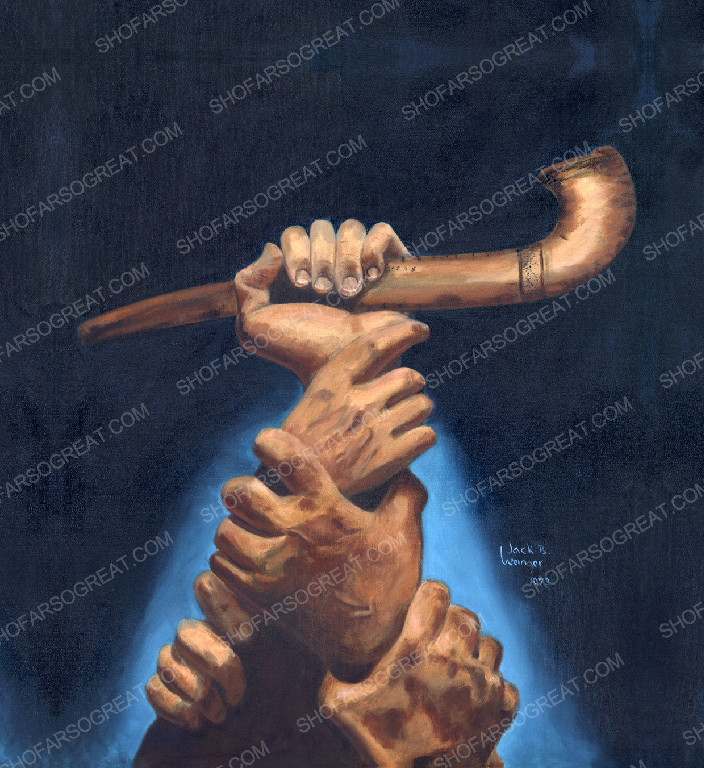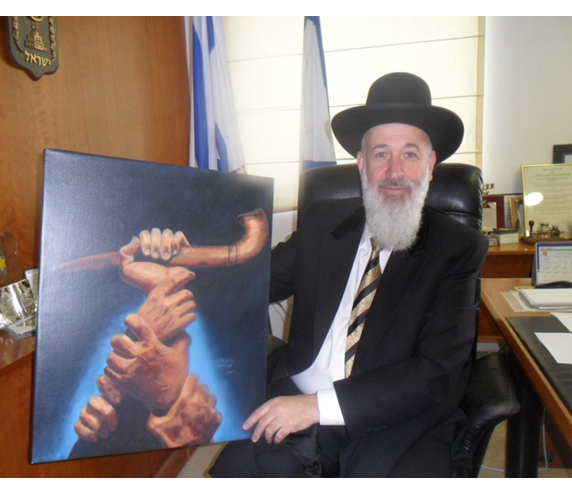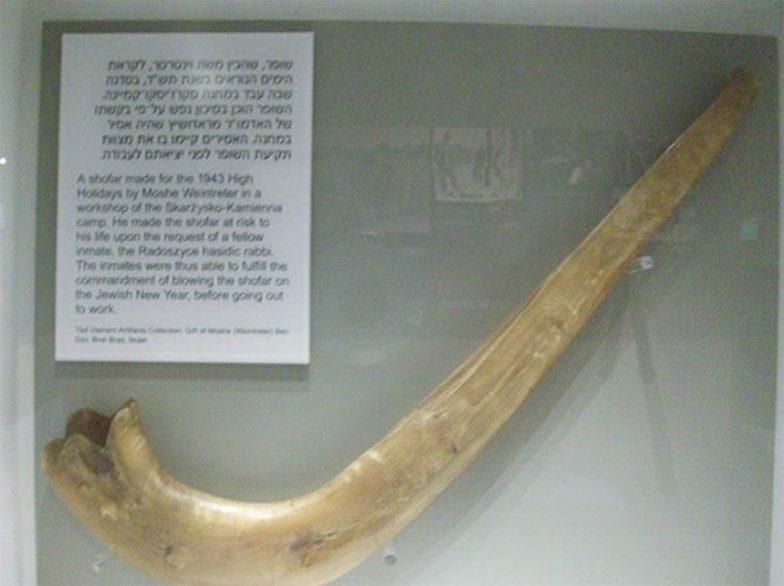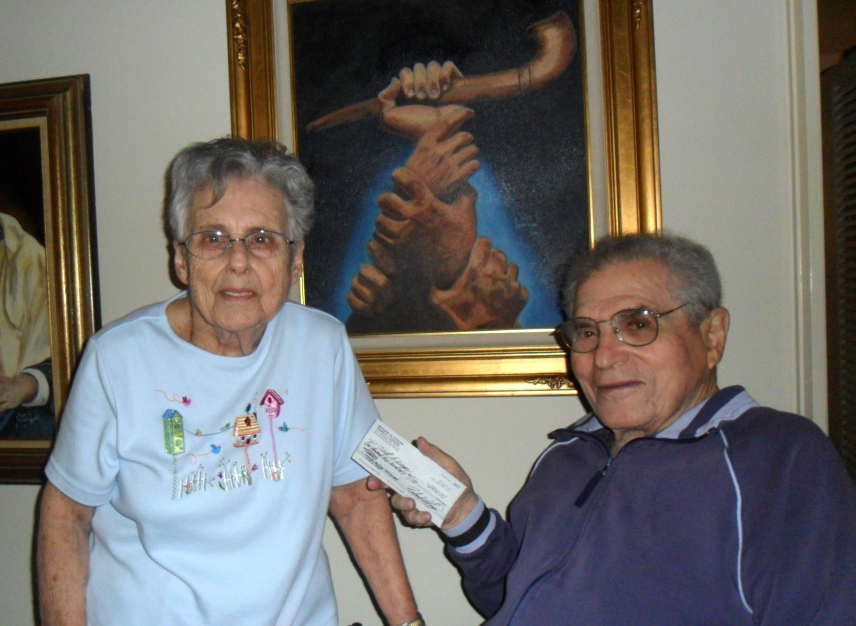
It is my honor and privilege to be able to offer a signed and numbered Giclée print of my father’s painting, “The Great Shofar.” It is a limited edition copy of the original oil painting, circa 1972, by Jack B. Weinger, born on September 3, 1917. Inspired by a magazine cover, Jack unwittingly created the prophetic foundation for Shofar So Great that would emerge some thirty-six years later.
The painting was completed prior to the “Day of The Great Shofar” and the 1973 Yom Kippur War.
The hands represent the Five Books of Moses, the Torah (Judaism’s foundation); the generations of Jews rising out of the ashes of the Holocaust and the rebirth of the State of Israel. It symbolizes the strength and victory of “Am Yisrael” (Nation of Israel), NEW life, and the cry of the shofar calling the Children of Israel home from the Diaspora. “The Shofar of Redemption!”
The story of “The Great Shofar” painting has taken on a life of its own. During a speaking
Two days later a couple in Dallas invited me out. At dinner, I happened to mention the painting and the story associated with it. The husband and wife looked at each other and she said, “Robert, we want to buy that painting for you. If we had our checkbook with us, we would give you $1,000.00 right now.” Ultimately, they purchased the painting from Dad. I was allowed to make prints with the stipulation that my parents would keep the original in their home until such time it would be given to me upon the ownership transfer of their home.
Not long after the first prints were produced, I remembered the story Israel’s former Chief Rabbi Metzger told me at his home where we met for the first time in March 2009. He told me about a shofar from Poland and the Yom Kippur War in 1973. Later I would recall an image of the only shofar displayed in the Yad Vashem Holocaust Memorial in Jerusalem from a concentration camp in Poland. I began connecting the dots. It seemed to me that the painting my father created in 1972 was a depiction of the story the Rabbi told me in 2009. I suspected that since the shofar from Yad Vashem was from Poland and was similar to the one Dad painted, it might look like the shofar buried in the sand in Rabbi Metzger’s anecdote from 1973, which is retold here in his own words:
“The story was when I was a soldier in the army during Yom Kippur war, I was a tankish…And, eh, we had a order to run away from the Syrian in the Golan Mountain in the beginning of the war until another group of soldiers came and helped us. And then we enter inside and we won. And we stood in the front near Syria was more than half a year. During this half-a-year the commanders allowed us to go back to that place where on Yom Kippur, I was the Chazzan (Cantor); I made the prayer there, and a soldier… I wasn’t a Rabbi then.

And I had a Kittel (priestly garment), and I prepare the shofar for Motsa’ei; for the finish of the Yom Kippur that we blow shofar. I prepared it in the corner, and in the middle of Yom Kippur the war started in two o’clock noon… and we left here. I enter this place after three months and when I arrived, I looked after the shofar.
So, the shofar was belonged to my grandfather from Poland and my father gave me it before Yom Kippur. We didn’t know that it will start the war and he said to me, ‘look, keep it with the Kittel because it’s not belong to you, it not belong to me, it belong from Poland some generations ago.
So please keep it.’ So I kept as I could be able to do, but when the war start we ran away. And, when I arrived back, I saw immediately the Kittel; but, the shofar I Iooked after and I didn’t find.
Two soldiers came with me, they said, ‘look, it’s very late and we have to go back to our place in the front;’ so the last minute we left the bunker, I saw something yellow form the sand. It was the place we put the mouth… the mouthpiece from the shofar and it was buried in the sand. So I took it out and it was full with sand; I put water inside and began to blow. It was one of the nicest blowing shofar that I did in my life.
…. And then I said the following idea: I said, look how we are similar to the shofar, Am Yisrael, why? The shofar is something that comes from a behemoth, a ram! And gentiles were at that time they thought that we are like rams, we are nothing; we are not human beings. They killed us; they bury us like the shofar was buried in the sand. But, the HaShem in the heaven took us out from the Holocaust from all the generations and build our country; and blow the shofar to go out from the Diaspora. The ‘Shofar of the Ge’ulah (Redemption).’ Like the shofar we were in all our history. It was buried and now it’s go up and went out to, to new life. So this is a story that I connected with all my soul to this shofar.”
On November 15, 2011, I met with Rabbi Metzger in his office in Jerusalem and asked him to tell me again the story of the shofar buried in the sand during the Yom Kippur War. He gave me permission to record the audio. Upon completion of the story, I asked, “Rabbi, by any chance, did the shofar buried in the sand in the Golan mountain look anything like this?” When I held up the painting, Rabbi Metzger was physically rocked and said, “Yes, the shofar buried in the sand on the Golan mountain looked like this.” As he reached for the print he said he was going to hang it in his office right there in Jerusalem.
Since the painting has “gone to market” it has become organic. If you look closely and have some imagination, the four-letter tetragrammaton for HaShem, “Yud, Hey, Vahv, Hey,” appears in the shadowing of the knuckles on the hand holding the hand that is holding the shofar. My father would never have consciously known to paint those Hebrew letters.
Leviticus 25:9 describes the special year of emancipation held every 50 years, the Jubilee or in Hebrew, Yovel, literally meaning the year of the blowing of the yovel, ram’s horn. Elul 29 on the Jewish calendar marks the end of the Jubilee Year 5777, fifty years since the Israeli victory in the 1967 Six-Day War where Chief Rabbi Shlomo Goren, at age 50, sounded a shofar at The Western Wall.

Excerpt: “A shofar made for the 1943 High Holidays by Moshe Weintreter in a workshop of the Skarzysko-Kamienna camp. He made the shofar at risk to his life upon the request of a fellow inmate, the Radoszyce hasidic rabbi. The inmates were thus able to fulfill the commandment of blowing the shofar on the Jewish New Year before going out to work.”

Elul 29 also refers to the biblical day where all debts are
How profound was it when I realized that Dad was born in that year of the Balfour Declaration on a day in Elul where we are commanded to hear the shofar for Jubilee and Rosh Hashanah? His fiftieth year happened to coincide with the reunification of Jerusalem in ’67 and his 100th birthday, September 3rd, aligned with the Jubilee year 2017, a prophetic representation of a double portion of Jubilee!!
I wish to take this opportunity to honor my father’s memory.
At 11:50 p.m. on the second day of Rosh Hashanah, September 23rd, 2017, he died at age one hundred, in his sleep without any pain which was his wish. His death marked the end of an age and the beginning of what I believe is the Messianic Age!
Giclee’ prints of his painting, “The Great Shofar,” the logo of Shofar So Great, hang in over 150 locations around the world; from The Great Synagogue in Jerusalem to Nairobi, Kenya, Australia, Denmark, at least a third of the United States including Texas, Georgia, California, New York, Delaware, New Mexico, Illinois, Mississippi, Alaska and Hawaii, Sri Lanka, Nigeria and beyond. Now his legacy lives on in the place he loved, Israel, at Beit Hogla East of Jericho. He was a fighter for Israel and I am committed to continuing his honorable fight.